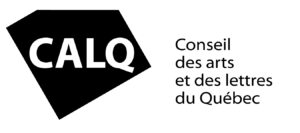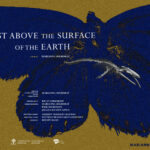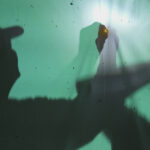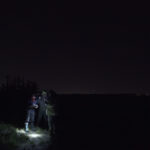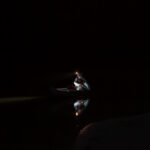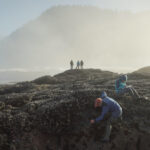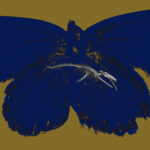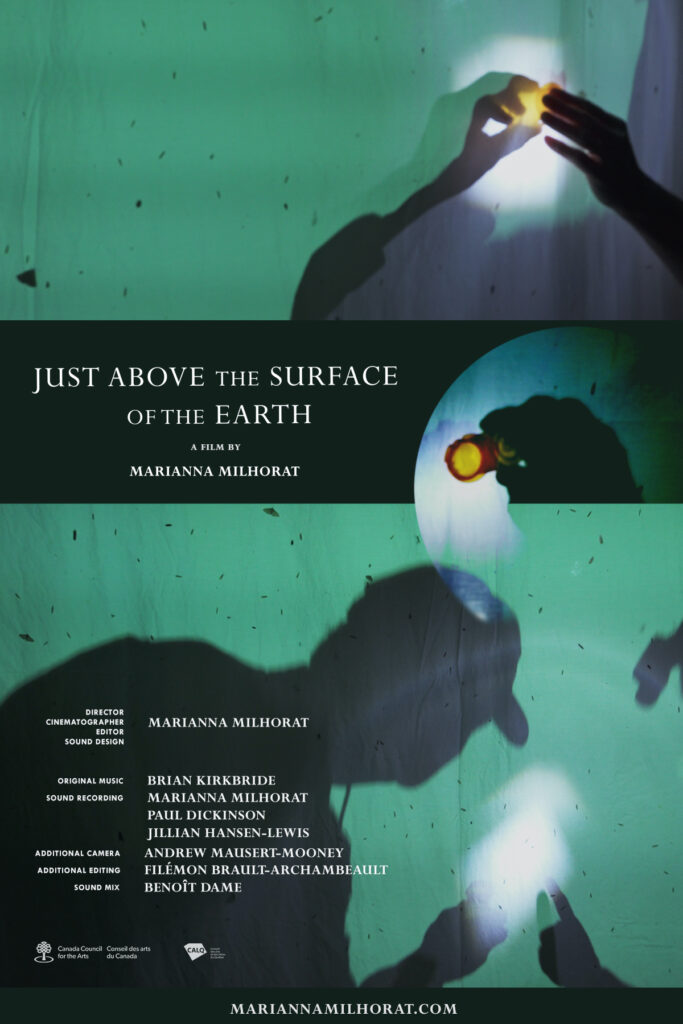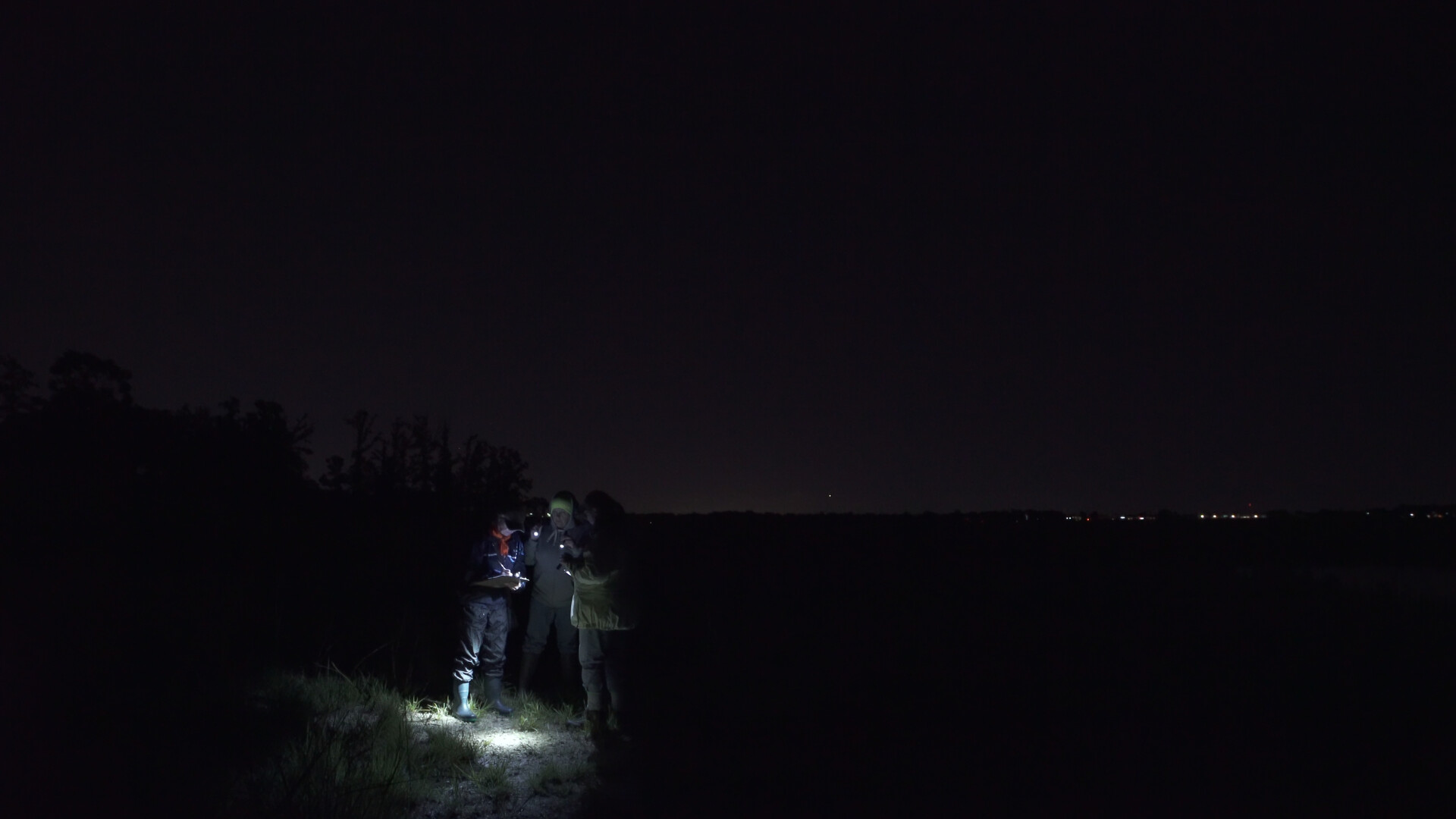
Just Above the Surface of the Earth (For a Coming Extinction) | 01:09:00 | 4K | 5.1 sound | 2024
A poetic portrait of contemporary wildlife conservation, JUST ABOVE THE SURFACE OF THE EARTH reflects on empathy, agency, and the role of hope in the midst of a sixth mass extinction. This debut nonfiction feature examines scientists and citizen scientists who conduct surveys of frogs, which serve as an indicator species; study sea stars threatened by disease; track bats whose populations have been decimated by white-nose syndrome; and collect data on insects declining at unprecedented rates. Set primarily at night, the film weaves together observational and lyrical sequences, texts written by authors including W.S. Merwin and Adam Nicolson, and an otherworldly soundscape.
JUST ABOVE THE SURFACE OF THE EARTH is a visceral, sensory meditation on what it means to live in a broken world.
—
Press Kit
—
Participation: Orland Grassland for the Calling Frog Survey at the Peggy Notebaert Nature Museum (IL), Multi-Agency Rocky Intertidal Network at the University of Santa Cruz (CA), Partnership for the Interdisciplinary Studies of Coastal Oceans (OR), The Nature Conservancy in Oregon (OR), Oregon Department of Fish and Wildlife (OR), Illinois Bat Conservation Program (IL), Illinois Department of Natural Resources (IL), Wisconsin Department of Natural Resources (WI), Kickapoo Valley Reserve (WI), Kitsap Beach Naturalists for the Multi-Agency Rocky Intertidal Network (WA), and Urban Ecology Center (WI)
Select Credits:
Director, Cinematographer, Editor, Sound Design: Marianna Milhorat
Original Music: Brian Kirkbride
Sound Recording: Marianna Milhorat, Paul Dickinson, Jillian Hansen-Lewis
Additional Camera: Andrew Mausert-Mooney
Assistant Camera: Jillian Hansen-Lewis, Kasandra Skistad
Additional Sound Recording: Nellie Kluz, Anthony Vicente-Pereira, Catherine Cross Uehara, Marie Ultreya Ullrich
Assistant Editing and Additional Editing: Filémon Brault-Archambeault
Re-Recording Mixer: Benoît Dame
Colourist: Hamed Aleali
Title Design: Dan Popa
Additional Music: Alvin Lucier, Chihei Hatakeyama
Adapted Text Excerpts: W.S. Merwin, Cormac McCarthy, Julianne Lutz Warren, Adam Nicolson, William Golding, Donald Culross Peattie, Leonard Dubkin, Louis MacNeice; Original Haiku: Marnie Baker
Narration: Wendy Hayden, Marnie Baker, Marianna Milhorat, Jacob Mahfoud, Sara Lefort-Depras, Nori Wei, Abdou Mbowe, Adam Mbowe, Jela Dela Peña, Natasha Hernández Canett, Anthony Jean-Louis, Anthony Vicente-Pereira, Wojciech Jakubiec
Support:
We acknowledge the support of the Canada Council for the Arts (canadacouncil.ca).
We thank the Conseil des arts et des lettres du Québec for its financial support (calq.gouv.qc.ca).
We acknowledge the support of Concordia University.
In partnership with the Forest Preserves of Cook County.
—
—
Director’s Statement:
JUST ABOVE THE SURFACE OF THE EARTH centers on the relationship between humans and animals within the conservation landscape. At the time of research and production, I was living in the Midwestern United States, which has a rich network of citizen science and wildlife monitoring initiatives. During typical wildlife surveys, participants carry out routine but visually striking data collection protocol to assess the health of threatened species. Although the surveys rely on community involvement, they often happen behind-the-scenes, after dark, or when parks and beaches are closed to the general public, rendering them alien to many. As I began field research for the film, what struck me was the experience—these suspended moments of waiting and searching for wildlife to appear, of spending time with a rather patchwork group of people, of submitting oneself to nature’s clock—as well as the odd, sometimes absurd visuals that conservation efforts produce. And from this new questions emerged: How can lived, sensory experience renew and inspire commitments to meaningful action? What do we learn from looking at images of modern conversation efforts?
Within the film, I focus on the poetic, experiential, and otherworldly nature of surveys through expository night visuals, structural techniques, and surround sound. I portray human figures as part of their surroundings, often overtaken by natural processes and phenomena or subject to the rhythms and patterns of their nonhuman counterparts—waiting, listening. I combine a painterly focus on the aesthetic qualities of landscape with audiovisual strategies and structural devices to amplify the psychological aspects and affective qualities of landscape, instigate perspective shifts, and encourage active reflection on our surroundings. In doing so, I wish to interrupt anthropocentric hubris to reveal a web of multispecies interconnectivity and mutual affect, reenchant the landscapes of the Anthropocene, and promote an ethic of kinship and care. For me, such an ethic is an urgent and necessary act of resistance against the objectification of the living world, which threatens the very survival of our planet.
I conducted research and production with the participation and assistance of a diverse range of individuals and groups: biologists and citizen scientists from the Calling Frog Survey at the Peggy Notebaert Nature Museum (IL), Illinois Department of Natural Resources (IL), Orland Grassland (IL), Urban Ecology Center (WI), Wisconsin Department of Natural Resources (WI), Kickapoo Valley Reserve (WI), Illinois Bat Conservation Program (IL), Dixon Springs Agricultural Center (IL), Multi-Agency Rocky Intertidal Network at the University of Santa Cruz (CA), Kitsap Beach Naturalists for the Multi-Agency Rocky Intertidal Network (WA), Partnership for the Interdisciplinary Studies of Coastal Oceans (OR), and The Nature Conservancy in Oregon (OR). Shooting took place over two years due to the short time frame that most efforts happen within: Sea star biologists monitor at the lowest tides of the year—usually a few-day window in the summer during the pre-dawn hours; acoustic bat monitors follow river transects, kayaking or canoeing down rivers at night, and require the light of a full moon; frog monitors count calls during frog mating periods and when the temperature and wind conditions are just right. The film adopts their patient approach, observing the monitors as they observe the night.
As the film progressed, I was continually moved by the quiet, humble dedication of the citizen scientists and scientists involved, yet could not help but question the exact utility of their efforts. This led me to reflect on the role—and utility—of empathy and hope in the midst of mass extinction. In post-production, I began incorporating diverse, lyrical texts—from authors including W.S. Merwin, William Golding, Cormac McCarthy, and Leonard Dubkin—as ways to further reflect on related questions. What I hope results is a film that conveys how embodied understandings of the natural world can inspire new forms of empathy and hope needed to not only fuel and sustain meaningful action, but also re-envision the future.
Poster Design: Dan Popa

